Ice scenes in Adriaen van de Venne’s Album, 1626
Nelly Moerman, author
Cis van Heertum, English translation
The album made by Adriaen van de Venne (1589-1662) is an extraordinary work. (ref.1) It dates from 1626 and it is one of a kind. Bound in red velvet and in a green morocco case, the album was originally in loose leaves, containing 105 coloured and numbered drawings the size of a small postcard (approximately 96 x 115 mm). (ref.2) The coloured drawings were executed in a gouache technique, some of them have extra decorations in silver and gold leaf. It must have been a costly album to produce.
A Gift from the Winter King and Winter Queen
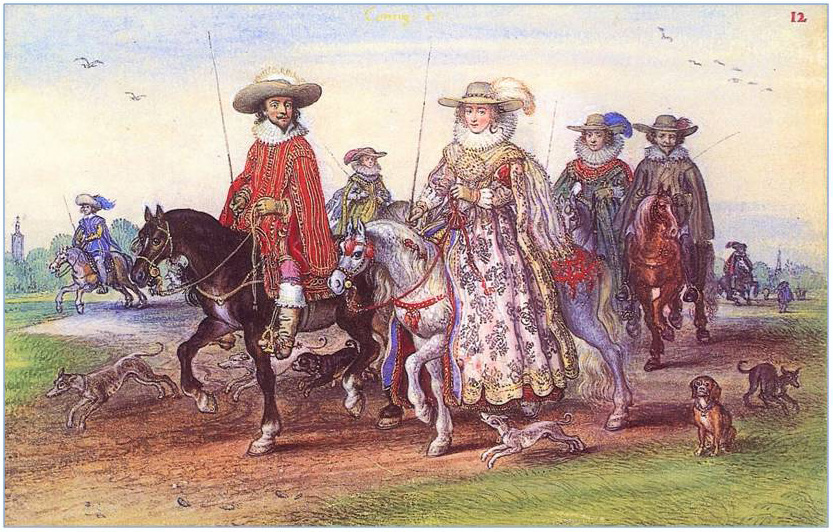
The album was a gift from the Winter King and Winter Queen to Frederik Hendrik (1584-1647), Prince of Orange and Stadholder of the Dutch Republic. The ‘Winter King’ was the sobriquet of Frederick V (1596-1632), Elector Palatine and King of Bohemia, because he held the throne for just a brief period. (fig.1, ref.3) His wife, the Winter Queen, was Elizabeth Stuart (1596-1662), the daughter of King James I of England. When the royal couple crossed from England to Holland in 1613, they were received with pomp and ceremony. They later became enmeshed in a political and religious battle in Frederick’s own country. The King was forced to leave Bohemia in 1620 and settled with his wife in The Hague, where he would live until his death in the former home of the ill-fated statesman Johan van Oldenbarnevelt on Kneuterdijk 20-24. At the time, The Hague had two courts: the Stadholder’s and that of the former King of Bohemia.
“A Gift to Seal the Bond”
Why the album was presented as a gift long remained unknown. There is no explanatory text to accompany the drawings, and it is uncertain whether there ever was one. It has been suggested in the past that the album might have been a New Year’s gift, or a liber amicorum, a book of friends. Another explanation is offered in the catalogue accompanying the exhibition Rivalen aan het Haagse Hof: Elizabeth Stuart en Amalia van Solms. (ref.4) This exhibition, which was held at the Haags Historisch Museum in 2014, highlighted the relationship between the two women. Prior to her marriage, Amalia van Solms (1602-1675) had been a lady-in-waiting of Elizabeth Stuart. She married Frederik Hendrik in 1625 and the album may have been a wedding gift. Might there not be more explanations?
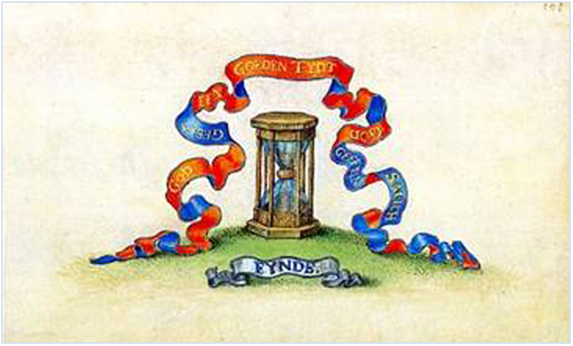
Martin Royalton-Kisch studied Van de Venne’s album extensively and described the album in the context of its time. (ref.1) He noted that the first part of the album, which is devoted to the Dutch armed forces, reflects the “political arena” of those days. The first leaf features a banderole containing the words ‘tLants Sterckte (The country’s strength). In Royalton-Kisch’s opinion this might have been included to stress the country’s strong position in the war against Spain. The last leaf of the album has a banderole which reads: God geeft een Goeden Tydt, God geeft een Saelich Eynde (God grants a good time; God grants a happy end). (fig.2) These words might also be interpreted in political terms and thus express the wish that the war may end well for the Dutch. Other aspects mentioned by Royalton-Kisch are close personal ties within the vast royal network, the Winter King’s hope of alliances between the Dutch, English and Danish nations and finally the marriage itself, which consolidated the ties between the two Courts at The Hague. (ref.5) Summarizing all these aspects, Royalton-Kisch provides an explanation why the album came into existence by quoting from the first leaf: “And what more appropriate way of sealing the bond than with a gift of an album entitled ‘tLants Sterckte?”.
Skating Scenes in the Last Ten Drawings
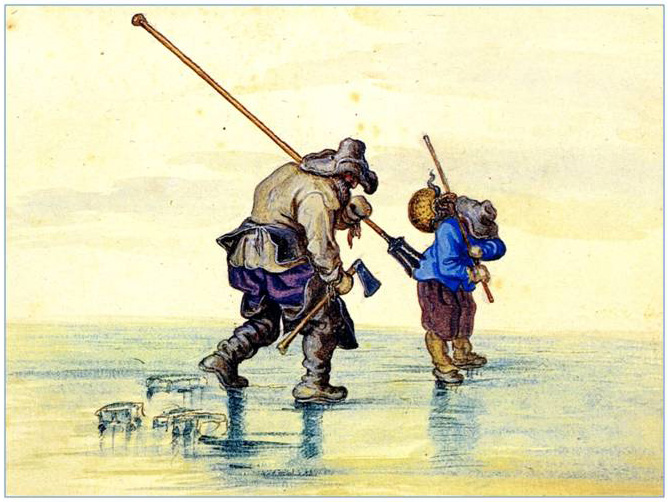
The album features people from all walks of life in contemporary society. All kinds of activities are represented, while the four seasons are also included. The last ten drawings are devoted to the winter season, with ice scenes depicting work, fun and misfortune on the ice. One of the images for example shows a fisherman at work. (fig.3) Carrying an axe in his hand and an eel spear over his shoulder, he is looking for a good place to make a hole in the ice. His companion helps him look for the right spot and carries a stick with an eel basket over his shoulder. A remarkable detail are the eels crawling out of the basket.
A Game on the Ice
It’s not only work on the ice, though, a game of kolf is also featured. (fig.4) A splendidly dressed nobleman concentrates on hitting the ball, while a younger kolf player is calling out to him from a distance.
The next drawing shows a small and elegantly dressed company enjoying themselves in a sleigh. (fig.5) The beautifully decked out horse is urged forward by the whip-cracking driver.
Three men on their wooden sledges (the type known as ‘prikslee’ in Dutch) also make for a remarkable scene. (fig.6) They each take a different direction and appear to be oblivious to the man who has fallen through the ice and is crying out for help. The man in the middle foreground even averts his face as he energetically pushes off with his sticks.
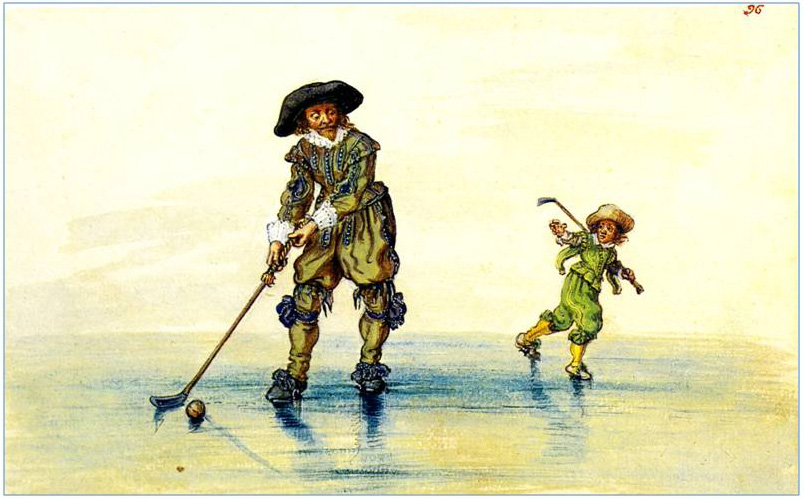
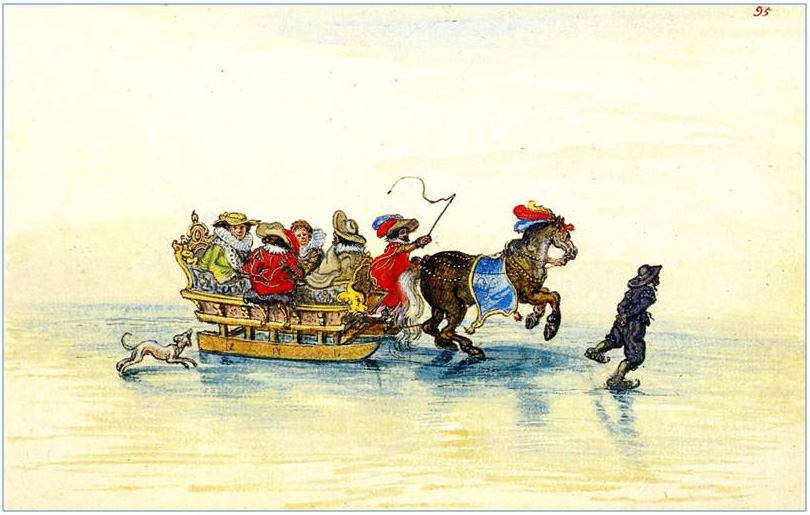
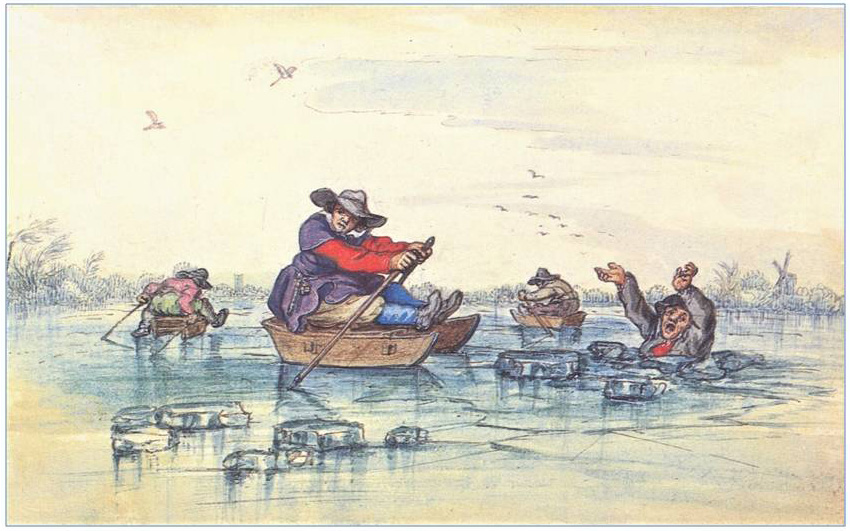
Accidents on the Ice
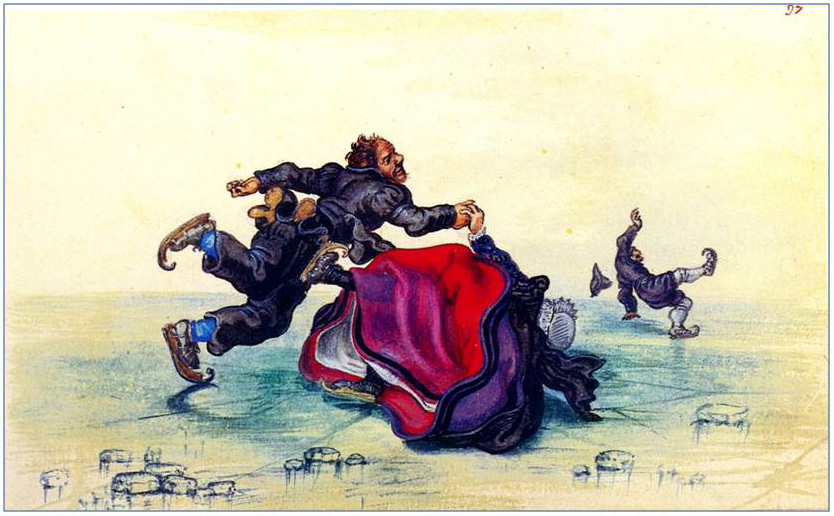
The series also has its fair share of accidents on the ice. A woman gets caught up in her skirts while skating and brings down her partner as she falls. (fig.7)
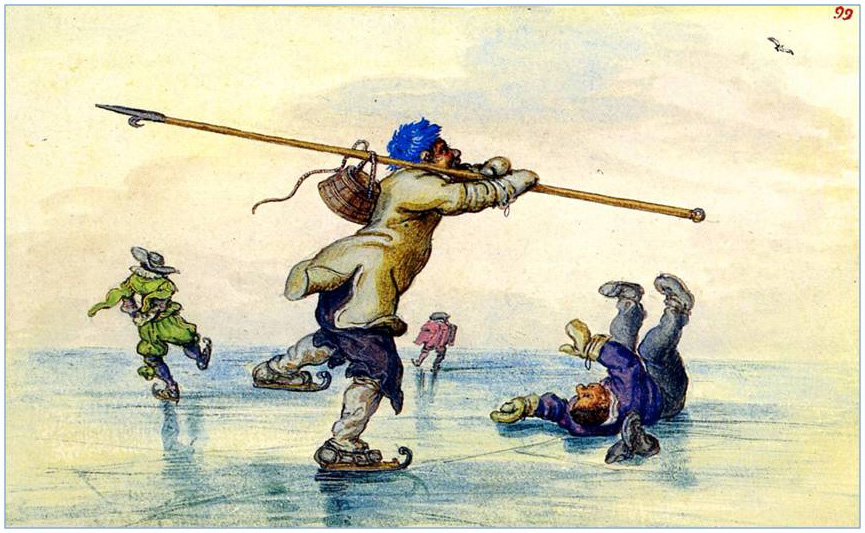
A man without skates also suffers a fall: he has tumbled over backwards. (fig.8) It seems like a warning that it is better to skate on the ice than to walk on it. This is convincingly illustrated by the skater in the foreground, who can be identified as a fisherman by his blue hat. He has just taken a stroke and glides away with perfect balance, his two hands resting on the long pike pole as a counterweight.
Hidden Meaning
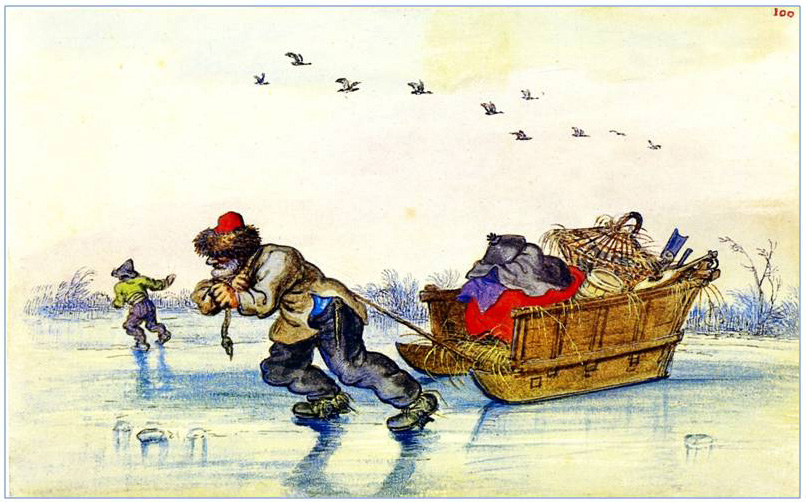
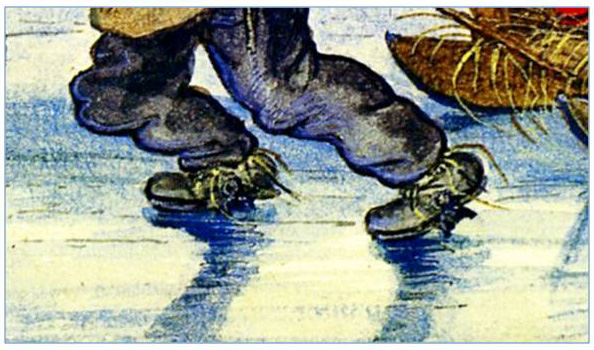
Adriaen van de Venne liked to make puns in his drawings and also drew inspiration from proverbs and sayings. One example is the drawing of a man laboriously pulling a sledge. (fig.9) Mark the ice tracks under his shoes. (fig.10) Sitting in the front is a sleeping woman with next to her a barrel leaning against the side of the sledge. In the back are a duck basket, a yoke and a few other objects. It looks as if this is all the man possesses. Judging from the ten birds in the air, it could be a depiction of the Dutch proverb that it is ‘better [to have] one bird in the hand than ten in the air’ (beter één vogel in de hand dan tien in de lucht, comparable to the English proverb ‘a bird in the hand is worth two in the bush’).
Sexual Connotation
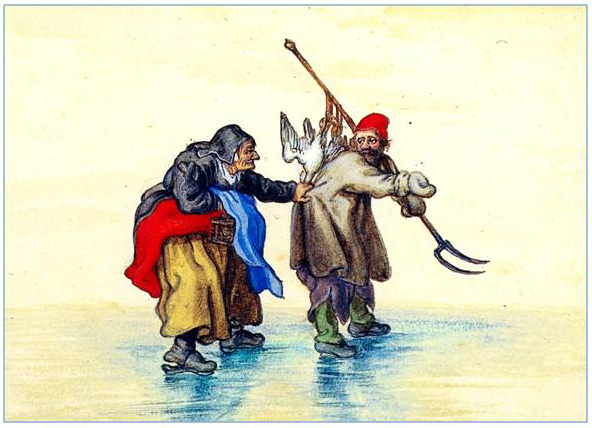
Another example of this extra layer of meaning is the aged peasant couple shuffling across the ice. (fig.11) The woman’s upper skirt has been pulled up. The red colour of the lining is a remarkable detail in the drawing. With her right hand she is holding a stove under her apron, as if she craves to be warm. With her other hand she is grabbing the man by his coat as if to get his attention. The latter carries a pitch fork over his shoulder with two dead birds dangling from the shaft. The image has a sexual connotation. The woman wants to get close to the man, while he for his part tries to keep her at arm’s length. The stove as a source of heat can carry an erotic meaning, while the two dead birds probably stand for the man’s failure in this respect. Nowadays such an image needs to be explained, but at the time the album was made, it was immediately obvious what was being conveyed.
Three Missing Drawings
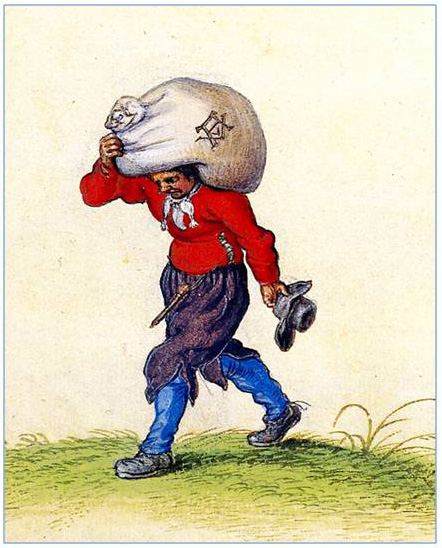
As mentioned before, the album originally consisted of 105 numbered drawings. In its present state three are missing, two ice scenes from the winter part and a third one from the summer part. It is unknown when exactly these images became detached from the album. The series of drawings was put up for sale in December 1749, when it was acquired by Viscount John Spencer (1734-1783) as a work by Pieter Breughel. This attribution was long accepted. Only around 1861 did a print dealer discover Adriaen van de Venne’s monogram on the sack carried by a porter over his shoulder. (fig.12) The drawings were bound in 1793, as appears from a leaf that was added to the album at this time, and remained in the Spencer family in this state for almost 200 years. The British Museum in London managed to acquire the unique album in 1978. Nothing was changed to its composition from the time it was bound, so that the three missing drawings must have disappeared before 1793.
The Mystery of the Three Lost Drawings
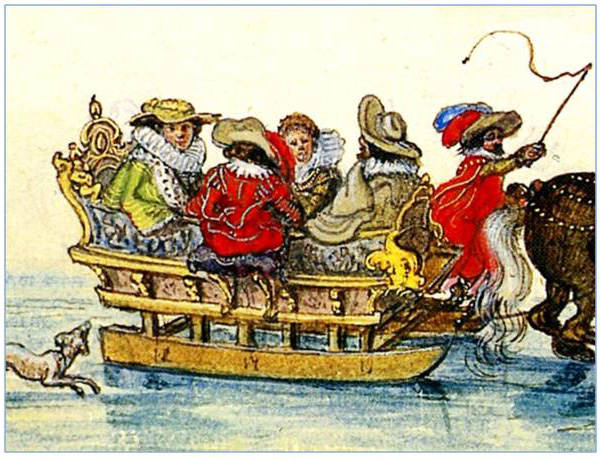
What might we have seen in the two lost winter scenes? It is well known that the Stadholder’s court at The Hague was fond of fun on the ice and liked to put on the skates in the winter. There is no evidence of this in Adriaen van de Venne’s album, though. The series does include an image of a merry and finely dressed company in a sleigh (fig.13), but a similar party on skates is not to be found in any of the drawings. Hendrick Avercamp (1585-1634), a contemporary of Adriaen van de Venne, did draw and paint richly dressed skating figures on more than one occasion. One example is Winter Scene on a Frozen Canal (c.1625), a painting now in Los Angeles.
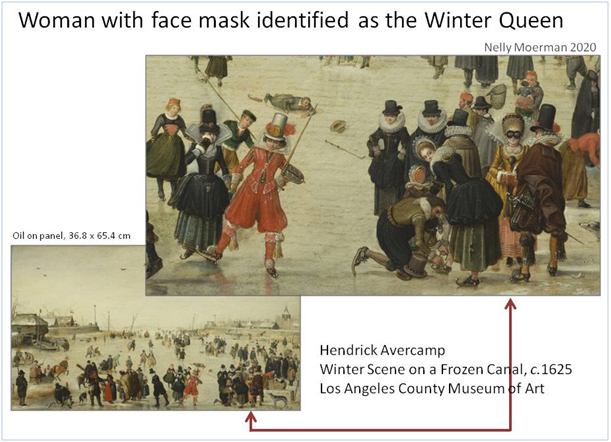
The woman on the right wearing a face mask is commonly identified as the Winter Queen, on the left an unidentified man dressed in orange, possibly Stadholder Frederik Hendrik.
The woman wearing the face mask on the right is generally identified as the Winter Queen. (fig.14) Although she is not on skates herself, the fun on the ice captures her attention. Some members of her party are, however, busy putting on skates. The skating man in the foreground on the left cuts a striking figure in his orange apparel. He has never been identified, but it might be Frederik Hendrik, Prince of Orange. In Adriaen van de Venne’s album Frederik Hendrik is also dressed in orange when depicted as army commander. As richly dressed skaters are featured in Avercamp’s paintings and also in other work of van der Venne, but not in this album, it is conceivable that they were depicted in the missing drawings. Perhaps they were portraits, and someone may have wanted to preserve them as a personal souvenir, removing them from the album when it was still in loose leaves.
Lost Drawings Ever to be Found Again?
Is there a chance that the lost drawings may ever be found again? Who knows. A collector reading this contribution may just happen to have in his or her collection a drawing that would seem to fit in with the others in Adriaen van de Venne’s album. There is only a very small chance, but collectors …. do have a look!
References
1. Martin Royalton-Kisch, Adriaen van de Venne’s Album, London, British Museum Publications, 1988.
2. The folio numbers of the original drawings are mentioned between brackets.
3. The drawing on folio 12 resembles a large grisaille (154.5 x 191) in the Rijksmuseum Amsterdam [cat.no. SK-A-958]
4. Nadine Akkerman, Rivalen aan het Haagse Hof: Elizabeth Stuart & Amalia van Solms.
Catalogue to accompany the exhibition of the same name at the Haags Historisch Museum, The Hague (2014).
5. Royalton-Kisch p. 109.
Credits
* Images 1-13 have been reproduced from Martin Royalton-Kisch’s Adriaen van de Venne’s Album (1988), courtesy of The Trustees of the British Museum. My kind thanks for their permission to use them.
* The original drawings from Adriaen van de Venne’s album can be found on the website of the British Museum, London.
* The painting by Hendrick Avercamp is part of the collection of the Los Angeles County Museum (LACMA) and is in the public domain.
This is a revised version of articles previously published in Kouwe Drukte 2014, year 18, no. 50, p. 16 and Kouwe Drukte 2014, year 18,
© Nelly Moerman 2020
This article is protected by copyright. Reproduction of the text, in whole or in part, is permitted only on an individual basis and under the conditions of acknowledgement of source and correct citation. In case of a financial interest or the pursuit of such an interest, copying is not allowed. In case of doubt, please contact the author.